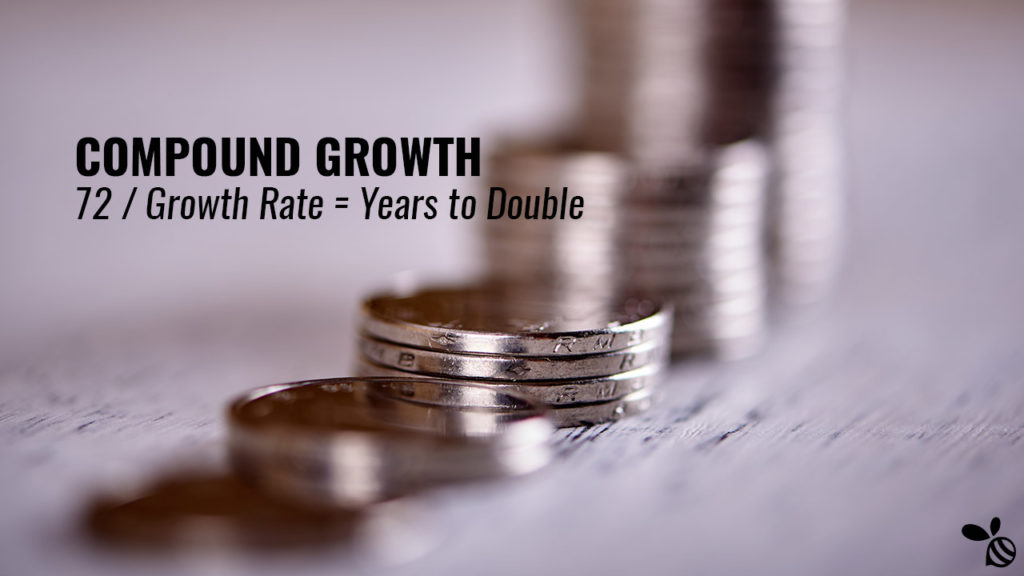
Albert Einstein was a big believer in compound interest. He called it the eighth wonder of the world, the most powerful force in the universe, and the greatest mathematical discovery of all time.
In Bogleheads’ Guide to Investing the authors write, “The power of compound interest and the accompanying Rule of 72 illustrate how anyone can slowly transform small change into large fortunes over time.”
The Rule of 72 is a simple calculation to determine how many years it will take an investment to double in value.
72 / Interest Rate = Years to Double
For example, at an 8% rate of return it will take 9 years to double the value of your investment.
No wonder investors get all hot and bothered about making small contributions to their portfolios on a regular basis. It just makes good investing sense.
The Rule of 72 is an equally intriguing formula to apply to your business. At your current growth rate, how many years will it take to double the size of your business?
It’s simple math. If your business is growing at a rate of 15% per year it will double in size in 5 years (4.8 to be exact). At 30% growth your company will double in size in 2.4 years, and at 5% growth you’ve got a 14.4 year journey ahead of you.
The concept of compound growth is fascinating, because 15% growth is not that daunting for a mid-sized company:
- At $5 million in revenue you need an additional $750,000 next year to achieve 15% growth.
- At $10 million you’re looking to grow by $1.5 million.
- At $75 million your growth target is an additional $11.25 million in revenue.
- And at $500 million you’ve got to find a whopping $75 million in new revenue.
Ok wait. I just blew a hole in my logic. 15% growth is pretty attainable when you’re small, but the larger you get the more compound growth gets in your way. The growth target just keeps getting bigger and bigger and bigger. And that means your business model, infrastructure, and brand all have to rapidly evolve to serve the ever increasing demands of compounding growth.
The realities of compound growth is why many companies face revenue plateaus.
Even though the realities of compound growth can become daunting the larger your company gets, the principle is still valuable. It helps to shape a growth strategy.
Say you want to double the size of your business over the next 5 years. Based on the Rule of 72 you’ve got to grow by 15% year over year for the next 5. For example, the growth rate for a company currently operating at $10 million would look something like this:
- $11.5 million
- $13.23 million
- $15.21 million
- $17.49 million
- $20.11 million
The challenge in this growth strategy is in years 3 and 4.
You can work smarter, harder, and faster to grow from $10 million to $13.5 million, but you will have to change your operations (including sales and marketing) to get through the $15 and $17.5 million milestones. Working harder won’t sustain the pressure of compound growth.
To deal with these realities I find it valuable to shift the strategic planning process into 3 time horizons.
10 Year Vision: If your company achieved all of its strategic goals, what would it look like 10 years from now?
A 10 Year Vision creates a mental image of where the organization is going. It should challenge and inspire your staff, customers, and stakeholders. It’s also a tool to push you through your near term growth objectives. Think of this like a boxer. You achieve power by punching through the target versus at it.
3 Year Growth Strategy: Create a near term growth strategy. In the example above, look just beyond the midpoint and consider how you will grow from $10 million to $16 million over the next 3 years.
How you decide to achieve that goal will be your 3 Year Growth Strategy. Growth strategies are typically achieved through a combination of 4 levers:
- Grow through scaling (organic)
- Grow through entry (new markets)
- Grow through acquisition (buy companies)
- Grow through innovation (create new products / services)
1 Year Action Plan: The 1 Year Action Plan is based on the 3 Year Growth Strategy. This is where you convert the strategy into executable chunks — what you’re going to do this year. It breaks down the key investments and priorities your team must take to achieve the company’s growth objectives.
An effective 1 Year Action plan clearly defines your company’s strategic priorities to grow the business. For some more insights on this topic read, Three Levers: Focus Your Strategy on Three Priorities.
By segmenting your growth strategy into 3 time horizons you can take advantage of the power of compound growth. Sure, the growth targets may look daunting in years 4 and 5, but what counts is what you do right now. You’re constantly laying the foundation, infrastructure and strategies for scale.
And hey, 15% growth next year isn’t that hard, right?
You're reading Compound Growth: How to Double the Size of Your Business by Jeremy Miller, originally posted on Sticky Branding. Did you enjoy this article? If so, sign-up for more of Jeremy's articles at Sticky Branding.
No comments:
Post a Comment